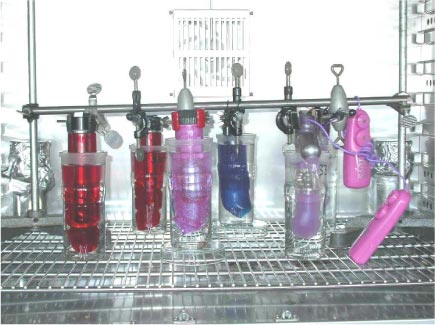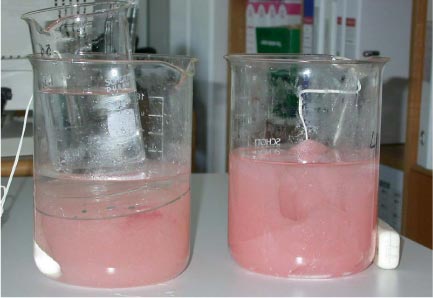Survey and health assesment of chemicals substances in sex toys
6 Migration analyses
- 6.1 Determination of worst case exposures and selection of simulant
- 6.2 Description of migration analysis method
6.1 Determination of worst case exposures and selection of simulant
The migration analyses are based on realistic worst case-scenario under relatively controlled conditions. The exposure is made with due consideration to contact time, surface area, temperature, etc, but for experimental reasons the contact period has been set to one hour, although the shops indicated more precise contact periods for the individual products (dildos/vibrators and artificial vaginas 10-15 minutes, gag ½-1½ hours). As to frequency of use the shops estimated that once a week was the normal for vibrators (dildos and vaginas). The use frequency of gag was estimated to 12 times a year.
As contact stimulant for products to be inserted into the vagina was used artificial sweat according to DS/ISO 12870:1997(E). 1st edition, adjusted to pH 4.5 with hydrochloric acid, which is the vaginal pH level of healthy women according to www.menstruation.com due to lactic acid bacterial flora. For artificial vagina artificial sweat with a pH level of 6.5 has been used and for gags with oral contact, we have used artificial saliva. The exposure period in all tests has been one hour and the temperature 40°C.
The analyses have been based on CEN final draft prEN-1400-3 (2002), however, this standard does not comprise artificial sweat, and the analysis method has therefore been adjusted accordingly. The results appear from Table 6.1-Table 6.3 with indication of exposed area and amount of contact simulant.
Experimental test set-up is shown in the photos below.

Photo 1 Dildo test

Photo 2 Artificial vagina
6.2 Description of migration analysis method
6.2.1 Sample preparation and exposure conditions
The test samples were immersed in the liquid simulant according to ”worst case” use, the vibrators being exposed at highest speed for an hour at 40°C.
Test sample no. 8 was after treatment tested with water based and oil based lubricant cream.
For the gag the test was carried out for one hour at 40°C in contact with artificial saliva.
A test portion of the extracts was added deuterium marked internal standards (benzene-d6, toluene-d8, p-xylene-d1, and DEHP-d4 and subsequently extracted with dichloromethane (DCM) in a separating funnel.
6.2.2 Analysis method
The resulting extracts were analysed by gas chromatography-mass spectrometry (GC-MS in scan mode).
The quantities of the detected substances were determined by comparing the peak areas of the internal standards and standards of the selected analytes.
Further, a test portion was analysed for content of volatile organic component by a headspace analysis.
6.2.3 Equipment
HP gas chromatography 5890 with a HP mass spectrometer 5972.
6.2.4 Analysis results
The results of the migration tests are summarised in the below tables.
Table 6.1 Migration analysis results for vibrators/dildos in vinyl in µg per dm² by 1 hour exposure
| Substance | CAS no. | Method | Sample No. | |||
| 2 | 8 | 11 | 15 | |||
| Exposed area in cm² | 163 | 120 | 168 | 164 | ||
| Artificial sweat, pH =4,5 iml | 214 | 244 | 213 | 214 | ||
| Plasticizers/Esters | ||||||
| DEHP | 117-81-7 | K | 1 | 6 | <0,5 | 5 |
| DNOP | 117-84-0 | K | 8 | |||
| DINP | 28-553-12-0 | K | <5 | |||
| Dimethyladipate | 627-93-0 | SK | 17 | |||
| Dimethyl-glutarate | 1119-40-0 | SK | 106 | |||
| 1-Methoxy-2-propyl-acetate | 108-65-6 | SK | 439 | 36 | 18 | |
| Dimethyl butanedioate | 106-65-0 | SK | 53 | |||
| Acids and Alcohols | ||||||
| 2-Ethylhexanoic acid | 149-57-5 | SK | 220 | 423 | 113 | |
| 2-Ethylhexanole | 104-76-7 | SK | 58 | 53 | ||
| Phenylethyl alcohol | 60-12-8 | SK | ||||
| Ketones | ||||||
| 2-Butanone | 78-93-3 | SK/HS | 49 | 12 | ||
| Cyclohexanone | 108-94-1 | SK | 1320 | 1001 | 382 | |
| Iso-benzofuranone | 84-41-2 | SK | 72 | 64 | 33 | |
| Coumarine | 91-64-5 | SK | 25 | |||
| Aromatic hydrocarbons | ||||||
| Toluene | 108-88-3 | K | 22 | 38 | 54 | |
| Other substances | ||||||
| Guanidine | 133-008 | SK | 925 | 32 | 36 | |
| Tetrahydrofuran(THF) | 109-99-9 | SK/HS | <0,5 | 12 | 12 | |
| Phenol | 108-95-2 | SK | 26 | 182 | 866 | 264 |
| Bisphenol A | 80-05-7 | SK | 21 | |||
| Vanilline | 121-33-5 | SK | 52 | |||
| Ethylvanilline | 121-32-1 | SK | 19 | |||
| 2-Ethoxy-propane | 625-54-7 | SK | 40 | |||
| Dipropylen-glykolmono- methyl ether |
20324-32-7 | SK | 309 | 471 | ||
| Tripropylene- glykolmonomethylether |
20324-33-8 | SK | 341 | 475 | ||
| Trimethyltin chloride | 1066-45-1 | SK | 99 | |||
SK = Semi-quantitative. K = Quantitative, HS = headspace
The migration value of water based lubricant is 40 µg per dm², for oil based lubricant the migration value is 5480 µg per dm², i.e. almost a 1000 times higher than without lubricant oil.
Table 6.2 Analysis results for artificial vagina in SEBS (no. 10) in µg per dm²
| CAS no. | Methods | Result | |
| Exposed area in cm² | |||
| Artificial sweat in ml | |||
| DEHP | 117-81-7 | K | 4,5 |
| 2-Butanone | 78-93-3 | SK | 17 |
| Benzophenone | 119-61-9 | SK | 20 –100 |
| p-tert-Butylbenzoic acid | 98-73-8 | SK | 20-100 |
Table 6.3 Analysis results for gag (no. 14) in rubber in µg per dm²
| CAS no. | Method | Result | |
| Exposed area in cm² | 38 | ||
| Artificial saliva in ml | 99 | ||
| Plasticizers | |||
| DEHP | 117-81-7 | K | 6 |
| Sulphur compounds | |||
| Carbon disulphide | 75-15-0 | K | 500 |
| Ethylisothiocyanate | 542-85-8 | SK | 5 |
| Tetramethylthiurammono-sulphide | 97-74-5 | 19 | |
| Phenols | |||
| Phenol | 108-95-2 | SK | 55 |
| o-(1-Phenylethyl)phenol | 4237-44-9 | SK | 35 |
| 4-(1-Phenylethyl)phenol | 1988-89-2 | SK | 14 |
| Other compounds | |||
| 3,3´-Oxydipropionitrile | 1656-48-0 | SK | 50 |
Based on the migration analyses the following substances have been selected for the health assessment:
- Plasticizers: DEHP (CAS no. 117-81-7) and DNOP (CAS no.
117-84-0) - Cyclohexanone (CAS no. 108-94-1)
- 2-Ethylhexanoic acid (CAS no. 149-57-5)
- 3,3´-Oxydipropionitrile (CAS no. 1656-48-0)
- Phenol (CAS no. 108-95-2)
- Carbon disulfide (CAS no. 75-15-0)
- Tetrahydrofuran (THF) (CAS no. 109-99-9)
- Trimethyltin chloride (CAS no. 1066-45-1)
By the selection due consideration has been paid to the expected long-term effects and the concentrations detected by the migration analysis.
Final prioritization result:
- DEHP
- DNOP
- Cyclohexanone
- 2-Ethylhexanoic acid
- 3,3´-Oxydipropionitrile
- Phenol
- Carbon disulfide
- Tetrahydrofurane
- Trimethyltin chloride
- Toluene
Version 1.0 September 2006, © Danish Environmental Protection Agency